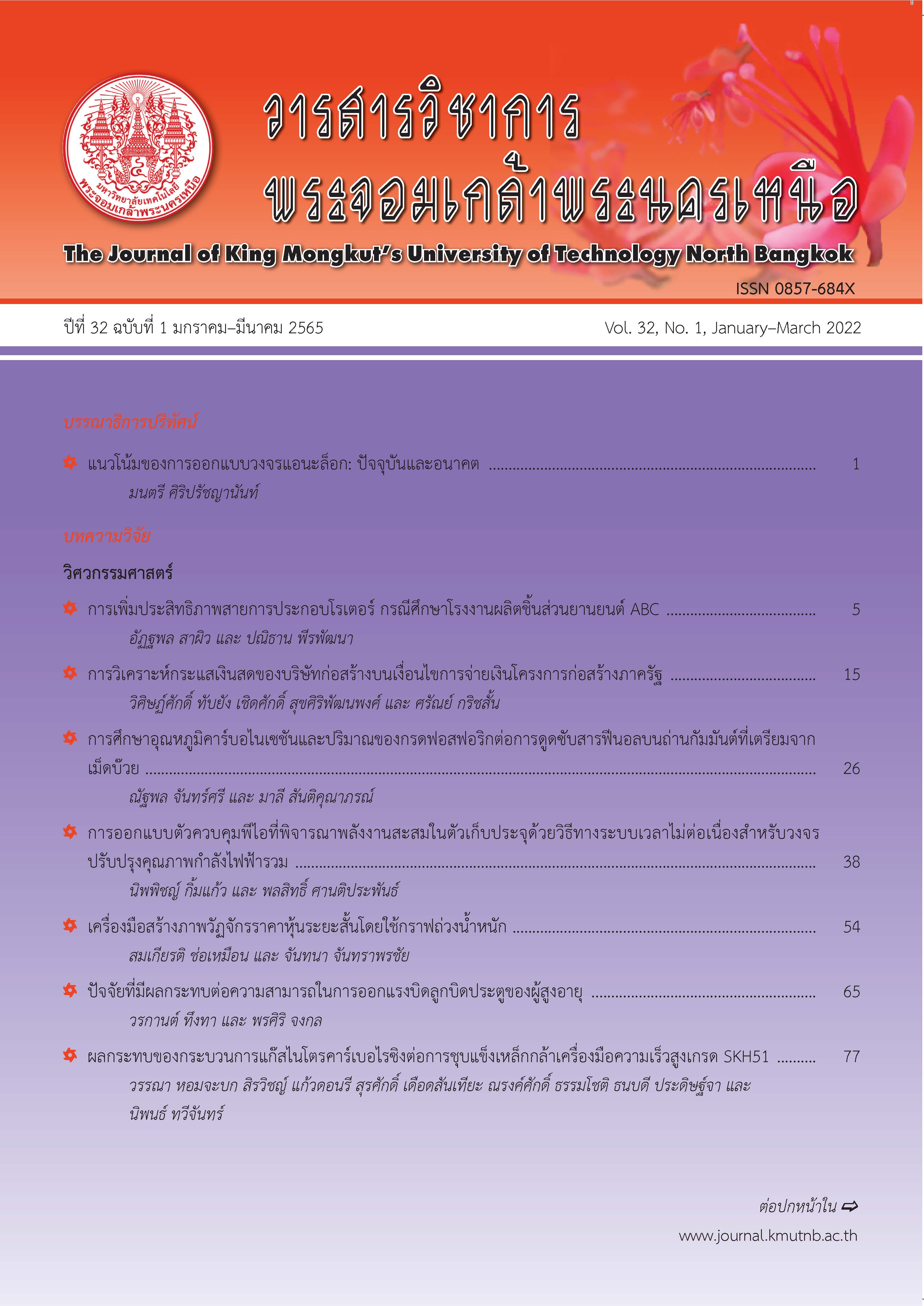สมบัติของมอร์ตาร์ที่ใช้เศษกระเบื้องหลังคาไฟเบอร์ซีเมนต์เป็นมวลรวมละเอียด
Main Article Content
บทคัดย่อ
งานวิจัยครั้งนี้มีจุดประสงค์เพื่อศึกษาสมบัติของมอร์ตาร์ที่ใช้เศษกระเบื้องหลังคาไฟเบอร์ซีเมนต์เป็นวัสดุนำกลับมาใช้ใหม่แทนทรายธรรมชาติร้อยละ 10, 20, 30, 40 และ 50 โดยปริมาตร ผลจากการทดสอบพบว่าความสามารถในการทำงานได้ของมอร์ต้าร์ที่ใช้เศษไฟเบอร์ซีเมนต์มีค่าใกล้เคียงกันและสูงกว่าส่วนผสมควบคุมเล็กน้อย ในขณะที่กำลังอัดที่อายุ 7 และ 28 วัน มีแนวโน้มลดลงตามปริมาณการใช้เศษไฟเบอร์ซีเมนต์ที่เพิ่มขึ้น อย่างไรก็ตามส่วนผสมที่ใช้เศษไฟเบอร์ซีเมนต์ร้อยละ 30 มีค่ากำลังอัดที่อายุ 90 วันเกือบเท่ากับส่วนผสมควบคุมโดยต่ำกว่าเพียงร้อยละ 10 นอกจากนั้นมอร์ตาร์ที่ใช้เศษไฟเบอร์ซีเมนต์มีอัตราส่วนโพรงและการดูดซึมน้ำเพิ่มขึ้น ส่วนผสมที่ใช้เศษไฟเบอร์ซีเมนต์ร้อยละ 50 มีค่าสูงกว่ามอร์ตาร์ควบคุมร้อยละ 194 และ 202 ตามลำดับ สอดคล้องกับการลดลงของความหนาแน่นที่ร้อยละ 8 และค่าการนำความร้อนที่ร้อยละ 40 บ่งบอกถึงสมบัติการเป็นฉนวนที่ดีกว่าเมื่อเปรียบเทียบกับส่วนผสมควบคุมรวมถึงความเร็วคลื่นผ่านตัวอย่างที่ลดลงร้อยละ 16 เมื่อเปรียบเทียบกับส่วนผสมควบคุม นอกจากนั้นการสูญเสียน้ำหนักของมอร์ตาร์เนื่องจากการกัดกร่อนของกรดซัลฟูริกเข้มข้นร้อยละ 3 ยังมีค่าต่ำลง โดยอัตราการสูญเสียน้ำหนักของส่วนผสมที่ใช้เศษไฟเบอร์ซีเมนต์ร้อยละ 50 อายุการแช่ 120 วัน ต่ำกว่าส่วนผสมควบคุมร้อยละ 43 ชี้ให้เห็นว่าการใช้เศษไฟเบอร์ซีเมนต์เป็นมวลรวมในส่วนผสมมอร์ตาร์ทำให้มีความทนทานต่อสภาพแวดล้อมเป็นกรดได้ดีขึ้น
Article Details
บทความที่ลงตีพิมพ์เป็นข้อคิดเห็นของผู้เขียนเท่านั้น
ผู้เขียนจะต้องเป็นผู้รับผิดชอบต่อผลทางกฎหมายใดๆ ที่อาจเกิดขึ้นจากบทความนั้น
เอกสารอ้างอิง
[2] Wikipedia. (2020, November). Construction waste. [Online]. Available: https://en.wikipedia.org/wiki/Construction_waste
[3] K. Nitichote and W. Yodsudjai, “Development of sustainable concrete by using of recycled aggregate in concrete,” Thailand Concrete Association Journal, vol. 5, no. 2, pp. 29–35, 2017 (in Thai).
[4] K. Schabowicz, D. Jozwiak-Niedzwiedzka, Z. Ranachowski, S. Kudela, and T. Dvorak, “Microstructural characterization of cellulose fibres in reinforced cement boards,” Archives of Civil and Mechanical Engineering, vol. 18, no. 4, pp. 1068–1078, 2018.
[5] A. Muller, T. Schnellert, and M. Seidemann, “Material utilization of fibre cement waste,” ZKG International, vol. 64, no. 3, pp. 60–72, 2011.
[6] T. M. Maya and N. Philip, “Mechanical properties of concrete containing roof tile aggregate subjected to elevated temperature,” International Journal of Innovative Research in Advanced Engineering, vol. 1, no. 8, pp. 255–261, 2014.
[7] I. Miličević, N. Štirmer, and I. B. Pečur, “Residual mechanical properties of concrete made with crushed clay bricks and roof tiles aggregate after exposure to high temperatures,” Materials, vol. 9, no. 4, pp. 295, 2016.
[8] A. B. Ceesay and S. Miyazawa, “Strength development and durability of concrete containing recycled roof tile aggregate,” Recycling, vol. 4, no. 3, pp. 29, 2019.
[9] I. Miličević, D. Bjegović, and R. Siddique, “Experimental research of concrete floor blocks with crushed bricks and tiles aggregate,” Construction and Building Materials, vol. 94, pp. 775–783, 2015.
[10] P. Nuaklong, A. Wongsa, V. Sata, K. Boonserm, J. Sanjayan, and P. Chindaprasirt, “Properties of highcalcium and low-calcium fly ash combination geopolymer mortar containing recycled aggregate,” Heliyon, vol. 5, no. 9, 2019.
[11] Standard Test Method for Relative Density (Specific Gravity) and Absorption of Fine Aggregate, Annual Book of ASTM Standard ASTM C128, 2015.
[12] Standard Test Method for Bulk Density (“Unit Weight”) and Voids in Aggregate1, Annual Book of ASTM Standard ASTM C29/C29M, 2009.
[13] Standard Test Method for Sieve Analysis of Fine and Coarse Aggregates, Annual Book of ASTM Standard ASTM C136/C136M, 2014.
[14] Standard Test Method for Compressive Strength of Hydraulic Cement Mortars (Using 2-in . or [ 50-mm ] Cube Specimens), Annual Book of ASTM Standard ASTM C109/C109M, 2013.
[15] Standard Practice for Mechanical Mixing of Hydraulic Cement Pastes and Mortars, Annual Book of ASTM Standard ASTM C305, 2014.
[16] Standard Test Method for Flow of Hydraulic Cement Mortar, Annual Book of ASTM Standard ASTM C1437, 2013.
[17] Standard Test Method for Density, Absorption, and Voids in Hardened Concrete, Annual Book of ASTM Standard ASTM C642, 2013.
[18] Standard Specification for Pulse Velocity Through Concrete, Annual Book of ASTM Standard ASTM C597, 2009.
[19] Standard Test Methods for Chemical Resistance of Mortars, Grouts, and Monolithic Surfacings and Polymer Concretes, Annual Book of ASTM Standard ASTM C267, 2012.
[20] Dry Mortar for Plastering, Thai Industrial Standards TIS.1776-2542, 1999 (in Thai).
[21] J. H. Kim, A. Qudoos, S. H. Jakhrani, A.-ur-Rehman, J. B. Lee, S. S. Kim, and J.-S. Ryou, “Mechanical properties and sulfate resistance of high volume fly ash cement mortars with aircooled slag as fine aggregate and polypropylene fibers,” Materials, vol. 12, no. 3, pp. 469, 2019.
[22] J. Dang, J. Zhao, W. Hu, Z. Du, and D. Gao, “Properties of mortar with waste clay bricks as fine aggregate,” Construction and Building Materials, vol. 166, pp. 898–907, 2018.
[23] L. Berredjem, N. Arabi, and L. Molez, “Mechanical and durability properties of concrete based on recycled coarse and fine aggregates produced from demolished concrete,” Construction and Building Materials, vol. 246, 2020.
[24] M. S. Nasr, A. A. Shubbar, Z. A. A. R. Abed, and M. S. Ibrahim, “Properties of eco-friendly cement mortar contained recycled materials from different sources,” Journal of Building Engineering, vol. 31, 2020.
[25] Non-Destructive Testing of Concrete - Methods of Test, Bureau of Indian Satandards IS 13311 (Part 1) : 1992, 2004.
[26] M. S. Zafar, U. Javed, R. A. Khushnood, A. Nawaz, and T. Zafar, “Sustainable incorporation of waste granite dust as partial replacement of sand in autoclave aerated concrete,” Construction and Building Material, vol. 250, 2020.
[27] B. S. Thomas, R. C. Gupta, and V. J. Panicker, “Recycling of waste tire rubber as aggregate in concrete: Durability-related performance,” Journal of Cleaner Production, vol. 112, pp. 504–513, 2016.
[28] P. Khamput, “A study of deterioration on mortars used quarry dust as fine aggregate due to sulfuric acid,” Srinakharinwirot Engineering Journal, vol. 1, no. 1, 2006 (in Thai).
[29] S. M. Joorabchian, “Durability of concrete exposed to sulfuric acid attack,” M.S. thesis, Department of Civil Engineering, Faculty of Engineering and Architectural Science , Ryerson University, 2010.

